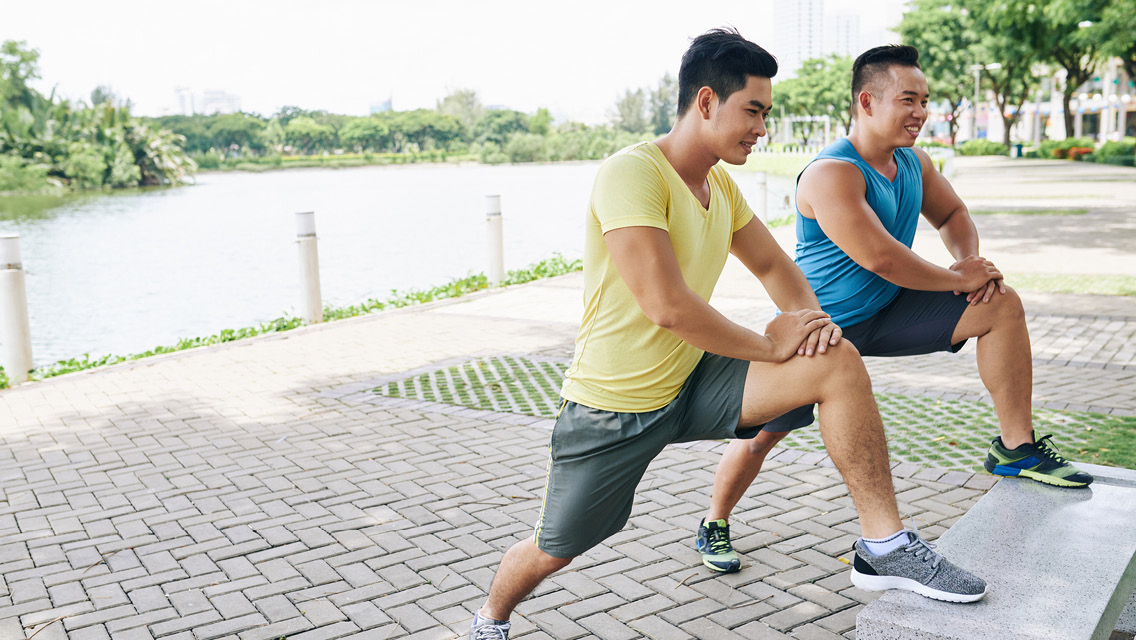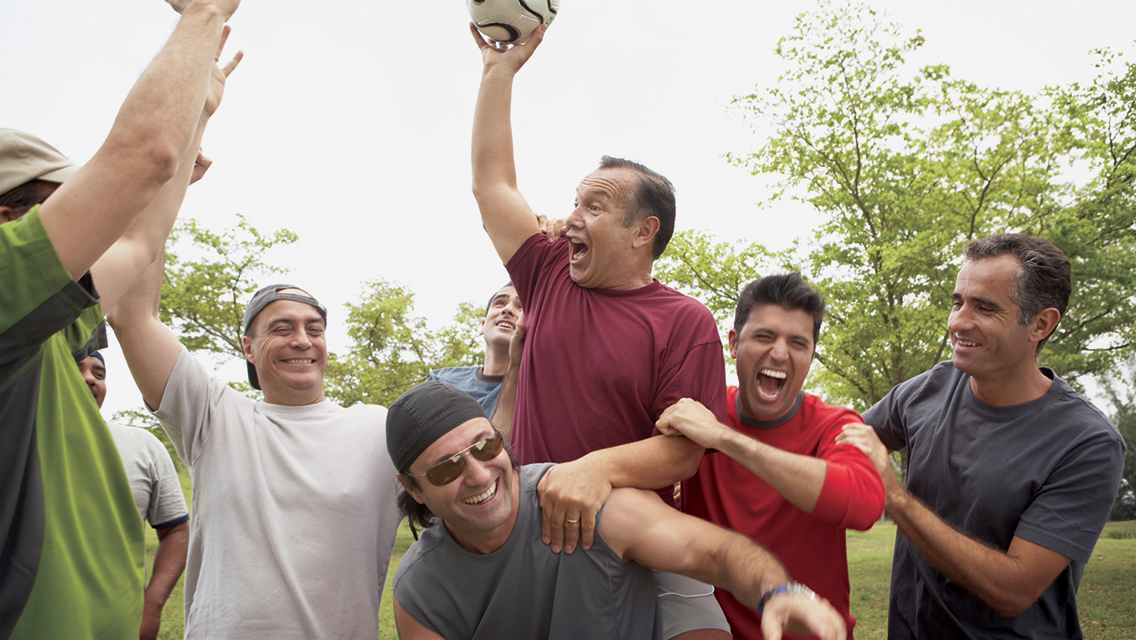If there were a way to double your chances for fitness success, would you be interested? How about a technique to make exercise more fun? A tool that automatically creates space and time in your busy schedule for workouts? A proven way to help you out of a rut or through a plateau?
It may all sound too good to be true, but countless fitness seekers have found that the right workout buddy can do all that and more.
“In my 10 years of experience evaluating what creates long-term health-and-fitness success, the single most important factor is having a support system,” says Wayne Andersen, MD, cofounder and medical director of Take Shape for Life, a nationwide health and lifestyle coaching program based in Owings Mills, Md.
Exercise partners provide a powerful combination of support, accountability, motivation and, in some cases, healthy competition. “They can play the role of teammate, co-coach and cheerleader — all while working out,” says Michelle P. Maidenberg, PhD, MPH, clinical director of Westchester Group Works in Harrison, N.Y.
Maidenberg, who consults on wellness-coaching strategies, says finding the right workout partner (someone you care about and click with) dramatically increases your chances of success. “A buddy can motivate you to do one more set, continue when you feel like you have just had enough and want to give up, or when you are feeling hopeless.”
The need for interpersonal support is primal, says Andersen. “We are social animals. We seek the company and positive reinforcement of others, especially when we are doing work.”
A 2011 study published in Psychology of Sport and Exercise found that the exercise habits of people you know have a positive influence on your exercise habits.
Another study, from the Department of Kinesiology at Indiana University, surveyed married couples who joined health clubs together and found that couples who worked out separately had a 43 percent dropout rate over the course of a year. Those who went to the gym together, regardless of whether they focused on the same type of exercise, had only a 6.3 percent dropout rate.
Ready to partner up? Great! But before you recruit the first warm body you see, keep in mind that not all workout buddies are created equal.
“If you choose someone who does not share a similar commitment to fitness, that can be a distraction or even a deterrent,” Andersen says. “And if your partner is at a radically different level of health, fitness or ability, you could be held back, pushed too hard or even injured.”
Another key factor: Emotional connection. Your workout pal doesn’t have to be your best friend, but he or she has to be someone you like and whom you wouldn’t want to disappoint, Maidenberg says. “Psychologically, if you feel like you have a responsibility and commitment toward another person, you are more likely to follow through on that commitment.”
The most successful fitness partnerships fall into one of three categories: the pal-based buddy system, the small group and the coupled pair. Take a look at them all, then consider which collaborative arrangement (or arrangements) might work best for you.
The Buddy System
A dynamic duo, typically friends or colleagues, who train together one-on-one or have developed a regular routine of connecting for fitness activities.
Best for: Those who shy away from gyms and fitness classes when solo, or who tend to be more introverted. Great for those focused on specific, shared or complementary goals (e.g., losing weight, getting stronger, training for an event). Ideal for pals who want to spend more time together and be more active. Also great for coworkers or stay-at-home parents.
“Finding time to work out around your job or the kids’ schedules can be challenging,” says Kara Thom, coauthor of Hot (Sweaty) Mamas: Five Secrets to Life as a Fit Mom. “So it makes sense to recruit the people you see on a regular basis.” Have a coworker join you for a lunchhour workout, she suggests, or exercise with fellow parents waiting around during a child’s music lesson or sports practice.
Why it works: “Having a reliable workout buddy increases your chances of sticking with your program,” says Elizabeth Lombardo, PhD, MS, PT, psychologist, physical therapist and author of A Happy You: Your Ultimate Prescription for Happiness. It can be hard to push yourself during solo workouts, she notes, and it’s dangerous to lift heavy weights without a spotter. A workout buddy can provide some healthy competition while keeping you within safe limits.
Plus, there’s a huge emotional benefit. “During a workout, more than our pores open up,” Thom says. “We find ourselves connecting with our workout buddies more intimately than we might if we were just meeting over coffee. Workout partners not only get us through a challenging workout, but can help us through life challenges as well.”
Potential pitfalls: “If your workout partner is down all the time, complaining, you will eventually lose motivation,” Lombardo says. Likewise, if he or she is too competitive, gives up too easily or is jealous of your success, it will bring you down. You don’t have to be perfectly matched fitness-wise (in fact, it can be helpful to exercise with someone who is a little fitter than you), but if you have dramatically different personality traits and divergent fitness goals, it can derail you, Andersen adds. Finally, beware of getting distracted with too much joking around or gossip. Your workout partner should make exercise fun, but not cause you to lose focus.
Success story: “From past experience, I know that I am more likely to go to the gym when someone is expecting me,” says Brandi Frommelt, 29, a mother of three girls who works out at Life Time in Tempe, Ariz. Initially, Frommelt used a personal trainer for motivation, but one-on-one training was never her long-term plan. “Ideally, I want to meet with someone three to four times a week, and working that frequently with a trainer just wasn’t in my budget.”
Frommelt then tried recruiting girlfriends to go to the gym with her. “I found out pretty quickly that although many women say that they will go to the gym with me, few ever do.”
She eventually discovered the best place to meet a reliable gym buddy is at the gym. “I realized that the people I saw there regularly already had the motivation to be healthy and active.” And, she knew their schedules aligned because she saw them consistently.
So last year, Frommelt gathered her courage and asked one of the regulars, Liz Poloskov, 32, to join her for a workout. The women have met faithfully three times a week ever since. “Our fitness goals are slightly different — she wants to lose weight and I want to build strength — but it gives us a nice variety of routines and exercises,” Frommelt says. “We rotate doing cardio and lifting.” The women also meet with separate personal trainers once every few months and use that information to develop new routines. “Partnering up has helped me to try different exercises that I would not normally do, which has pushed my fitness forward.
The Group Effort
A small group of people whose membership may vary by the day, but who generally work out at the same preappointed time and place — as a group, with a trainer, or simply in the same vicinity as one another.
Best for: People who like to combine social time with exercise; coworkers, students or parents whose schedules align; cyclists, walkers and runners, or any group of fitness-minded friends. Also great for people who like the interaction of a group but may not want to participate solo in a bigger group fitness class.
Why it works: Whether you’re jogging shoulder-to-shoulder with buddies or simply glancing across the fitness floor at familiar faces, there’s a strong motivation in the feeling that “we’re all in this together,” Maidenberg says. “A group normalizes the need to maintain effective health-and-fitness behavior and promotes a feeling of community.”
If you’re feeling challenged or losing steam during a workout, you can look around and find a bit of empathy or encouragement from your peers to pull you through. “The group provides a vehicle for support, for problem solving, or to gently confront and hold one another accountable if an individual is straying from the goals,” she says. Partnering with more than one person also acts as a safety net; if one person bails, there are others who will still show up. (For more on the benefits of group fitness, search for “Group Effort”.)
Potential pitfalls: It can be more difficult to schedule workouts with multiple people, so you’ll want to develop a reliable system (e.g., phone tree, group texting or an online calendar). Pick regular workout times and stick to them, even if one group member doesn’t show. It can be a challenge to find or design workouts that meet everyone’s needs; good communication and periodic goals evaluation are key. Or you might try regularly attending a group fitness class together.
Success story: Mathew Kasel, CPT, assistant personal-training-department head at Life Time in Tempe, Ariz., has witnessed several small-group success stories over the years. Kasel says small groups (three or four friends or coworkers) will often hire one trainer to save money and make training sessions more fun. “A good trainer can adapt a routine so it meets a group’s needs, even if everyone’s at a slightly different level,” he says. You can perform circuits with varying free weights and kettlebells or use cardio machines side by side. It’s easy to vary resistance and modify certain moves for each person, he says. And it allows you to pair off and do two-person exercises with resistance bands or medicine balls that you can’t do alone. (For partner-assisted resistance-band exercises, search for “Band Together”.)
Kasel trains one group consisting of two executives from the same company, along with a few of their family members. “They started coming together because their work schedules were similar, but they found an unexpected benefit,” he says. The execs, in addition to meeting their fitness goals, have discovered that their shared workouts translate to better problem solving and teamwork in the boardroom. “Working out together has actually expanded their communication about their business,” Kasel says.
The Couple Collaborative
A romantic twosome who pursue their fitness activities together. They may or may not do the same workout, but they block off time and space for being active as a couple.
Best for: Romantic partners who support each others’ goals; couples who need more quality time together and have trouble fitting it in their schedules; parents who can take advantage of childcare at the gym; anyone looking for a fun, active date.
Why it works: You’re most successful at reaching your goals when the people closest to you are on board — or, better yet, an integral part of the team. Scheduling is often easier with a partner, since you can carpool to the gym. All those endorphins and pheromones work to increase your attraction, too. “When you’re empathetic and praise your partner during a workout, it spills over into your relationship,” says Lombardo. You learn you can tackle anything as a team, and that makes for a stronger relationship.
Potential pitfalls: If either of you is given to bickering, bullying, pouting, competing too aggressively or sabotaging the other’s workouts, nobody’s going to benefit. Before you start a workout routine with your sweetheart, discuss how you’ll handle situations such as one person bailing or pushing too hard. Talk about your goals (shared and individual) and how you can best encourage one another. You might also make a “no criticism” rule during your workouts.
Success story: Shelagh Hodson, 61, a writer in Rochester, N.Y., has always walked to stay fit, but she took a fairly casual approach to her routine. “If I wanted to skip my daily walk, my excuse had to satisfy only me — and I was easy,” she says. When her husband’s joints became less tolerant of running a few years ago, he switched to walking with her. But he wanted to maintain a more rigorous pace than she was accustomed to. “Not only does he encourage me to go faster and farther than I might have, but he doesn’t make many excuses.” As a result, she skips fewer workouts and works harder than before. “I’m a lot fitter now than when I was walking alone!”
For other couples, like Stephen and Susann Paige of Tucson, Ariz., exercising together has built trust, respect and attraction. The Paiges have been married for 26 years and find time to exercise outdoors together several times a week, usually running, hiking or mountain biking. “Stephen is assured in his outdoor skills and I’ve learned to trust his instincts,” Susann says. “I bring a light-hearted approach and find what’s funny in situations. We rely on each other’s strengths.” Exercising together keeps them feeling good about themselves, and that translates to a stronger romantic spark, too. “Flirting along the way and comments like ‘nice quads’ keep us hot on each other’s tails, so to speak!”
Keep in mind, whether you’re currently working out with your spouse, a buddy or a whole passel of fitness pals, there’s no need to limit yourself to just one fitness partnership. You can hit the gym with your sweetie a couple of evenings a week, walk with a colleague over the lunch hour and ride trails with your cycle club on the weekends. The more people you have actively engaged in supporting your fitness efforts, Andersen says, the more likely you all are to enjoy the process, and the results.
How to Be a Fab Fitness Buddy
Build your active partnership with thoughtful acts of support like these:
- Be in touch. Send reminder texts or emails, prearrange rides to the gym, offer wake-up calls if necessary.
- Be on time. Always.
- Push your partner, then reinforce her efforts with praise.
- Suggest new ideas and routines to keep things interesting and prevent plateaus. (Browse the Experience Life archives for workout ideas or consult a trainer every few months.)
- Remind your partner of his goals and encourage him when the going gets rough.
- Keep tabs on each other through illness, travel and other routine-breakers. It will make it easier to get back on track.
- Talk about topics other than fitness. The more you care about your partner as a person, the stronger your alliance will be. But don’t wallow in negative talk. It’s an energy downer.
- Be flexible. Sitter canceled? Take turns watching the kids so each of you can exercise independently.
This article has been updated. It originally appeared in the July/August 2012 issue of Experience Life.




This Post Has 2 Comments
this is a good article , but what happen if you do not have a fitness partner?????
Great article, thank you.